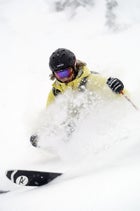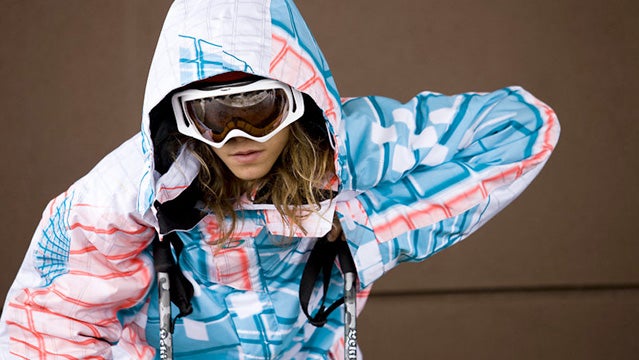As a kid, Kye Petersen, 22, used to head up into to the mountains around his Whistler, British Columbia, home to get away from things. His father, the acclaimed ski mountaineer Trevor Petersen, died in 1996 when an avalanche swept him down the Glacier Rond’s Exit couloir in Chamonix, France. Kye was six.
The Snow Report
The latest snow, ski, and winter sports stories from ���ϳԹ���. Kye Petersen.
Kye Petersen.That’s how he learned to ski, Petersen says—taking it up into the hills, following older kids around, and just throwing down. These days, he’s perhaps the best skier of his generation—combining big-mountain bravado with terrain-park creativity. His skiing is bold, powerful, and fluid, and has caught the eye of everyone from Eric Pehota, his father’s former ski partner, to Seth Morrison.
In 2005, a 15-year-old Petersen made his first pilgrimage to Chamonix. With Glen Plake as his mentor, Petersen skied the Exit couloir, where his father had perished. His eyes were opened to Chamonix, ski-mountaineering, and some realizations about his father’s death—which was documented in the film . Since then, he’s earned his place among the pantheon of big-mountain skiers. In 2009, he won the Red Bull Cold Rush, a proving ground for big-mountain athletes, edging out veterans JP Auclair and Sage Cattabriga-Alosa. He was 19. Last January, he won the Freeride World Tour competition in Revelstoke. He pretty much showed up at the last minute, then crushed his competition by hucking two 360s and a double drop in the semi-final round, then topping that off in the finals by throwing another 360 and stomping a massive cliff.
In the Sherpas’ 2011 film, , Petersen had one of the main segments, in which he popped a natural rodeo seven on a steep face in B.C. I was at Mica Heliskiing Lodge while the Sherpas were shooting this segment. When the crew—JP Auclair, Callum Pettit, Rory Bushfield, Dave Mossop and Eric Crossland—returned to the lodge that day, they were reeling with stoke, eyes lit up. Petersen was on another stratosphere.
At the moment, Petersen’s been getting ready for the season, lapping up early snow around his Whistler, B.C., home, and working on his segment in the new Sherpas Cinema film, , to be released in fall 2013. Here he talks about his dream ski trip, what it means to be “chamified,” and a recent mission to Bolivia.
You were in Bolivia this summer—what was that all about?
I was there in September with the Sherpas Cinema crew and Callum Pettit, Johnny Collinson, and Kris Erickson. We skied a couple of peaks, mainly Huayna Potosi, a 6,000-meter peak outside of La Paz. It was cool. Totally different. We hit it later in the season, so we missed snow and had to ski some icy conditions. We definitely rushed into it quick. It was all about getting through it and learning about altitude. We learned from our headaches and we ended up making it.
How would you describe your skiing style?
Playful. When I look at a slope, I just try to have as much fun as I can.
Where is your favorite place to ski?
Whistler or around British Columbia’s Coast Range.
What is your dream ski trip—if you could go anywhere, unlimited budget?
That’s hard. If I had to pick, dream trip would be Bella Coola—blue skies for two weeks and fat snow conditions with a heli at hand and tons of gear to ski in the backcountry for days and ski big lines.
In The Ordinary Skier, you said you’d been “chamified.” Can you describe what that means to the layman?
Yep, I’ve been chamified for sure. It basically means when you go to Chamonix and you stay for long enough, you kind of get crazy. It’s a psych on the sport and culture. There’s just a wild culture there. The people that live there have to be pretty psyched on what they do to do all the gnarly stuff. The mountains there are spooky, you know?
What was the experience like of skiing with Seth Morrison and Glen Plake during the filming of The Edge of Never?
It was really cool to get hang with those guys, especially Plake. It was a really good opportunity. I tried to take in as much as I could from them at the time.
What was it like to ski the Glacier Rond and the Exit couloir, where your father died?
Being there in Chamonix for the first time, in general, opened my eyes to a lot of things and helped me realize a lot of things about that, I guess. It was a really good experience. And since then, I’ve had other really good experiences in Chamonix.
Given that death has brushed your life so closely and you’re well aware of the consequences and risks of skiing, does that change your outlook on what you do?
No, not at all. It’s part of life and a part of what we do. It just shows you how powerful life is and you really have to be thankful and just enjoy it. Keep doing what you’re doing because that’s what makes you happy.
We all know what the pros are of being a pro skier—skiing all over the world, heliskiing all the time—what are some of the cons?
For me what I love is that there’s not much of a downside to it. But I do a lot of stuff as far as work goes that’s not skiing, more than people probably think.
What have been your career highlights so far?
I don’t think I could pick just one. I think the biggest highlight is just getting to where I am now and keeping on moving forward. There’s been a lot. If I had to name a few standouts: winning the Red Bull Cold Rush in 2009, the Freeride World Tour at Revie last year, hitting Pyramids Gap when I was 15, the number of lines I’ve skied that are totally rad.
What’s the biggest change in your own skiing in the last two years?
Every year, learning more. Skiing new lines, ski-mountaineering style. And then at the same time, trying to get confident with tricks in the backcountry and hitting multiple features and things like that.
What’s the difference between skiing in North America and skiing in Europe?
Ski culture kind of began in Europe and you feel that when you’re there. As far as extreme skiing, it all started there and people have been doing that for a really long time over there and it shows.
Who do you admire? Who are your influences?
That’s not really answerable. It’s not just one. There’s so many for me. Skiers, snowboarders, skateboarders. I have tons of influences. And pretty much everyone I ski with influences me. I’m a big fan of skiers of all eras.
Where do you see the sport going?
Right now it’s going in a good direction, I think. Ever year, people are getting better and better. It’s going to a crazy place.
Who are your favorite ski partners?
That’s hard, too. I have so many. I’ve got quite a few buddies around Whistler that I grew up with like Callum Pettit—I ski with him a lot. My buddy Matty Richard, I ski with him a lot, too. There’s so many.
Who taught you to ski?
I guess me? When I was pretty young, I just went up the hill to get away from everything. I learned a lot from just following other skiers who were older than me around the mountain.
When did you skiing professionally become a reality for you?
When I was 11, 12, I knew this is what I wanted to do.
How old were you when you first got on skis?
About four.
Do you prefer competitions or filming?
Filming, because it gives me more of an opportunity to be creative and do what I enjoy doing.
What’s on tap for the winter?
I’m shooting with the Sherpas this winter a lot around Whistler and Revelstoke. In the spring, everything is pretty undetermined right now. Bella Coola or Alaska—somewhere up north. I’m pretty much working exclusively with the Sherpas this season; that’s my main project for the winter.
What’s different about this film than the one before?
This one is supposed to be about human nature. It’s called Into the Mind—it’s about how we react to life and fun and all that kind of stuff. That’s all I know. It’s going to be pretty cool.
What have you learned from working with the Sherpas?
It’s really given me the opportunity to achieve what I want with my skiing. It’s allowed me to express my skiing more than before.
You won the Freeride World Tour in Revelstoke last year. You’ve won Red Bull Cold Rush—do you have any comps lined up for the winter?
I’m up in the air about that. I’m going to be focusing on this other stuff, so I don’t think I’m going to do much competing, unless there are some last minute opportunities that pop up.
What are your goals for your career?
Mainly to keep exploring my home, skiing lines, hopefully first descents. Just try to progress on skis. Learn new things in terms of creativity. Stomp lines and just continue bettering my skiing.


